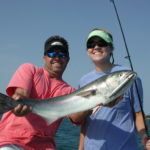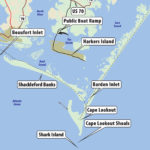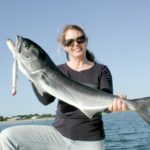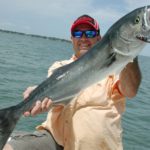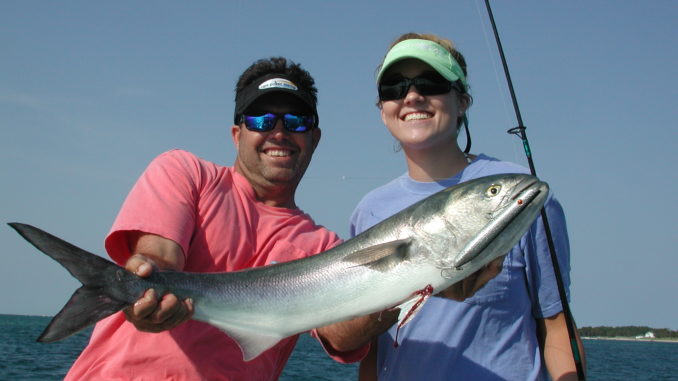
Topwater action is unparalleled when big blues arrive in the Cape Lookout hook this month.
The water inside the hook at Cape Lookout was absolutely flat calm as the sun peeked over the dunes and around the lighthouse on a windless May morning. Capt. Noah Lynk of Harkers Island was idling along the edge of deeper water beside the shallow flat that runs along much of the inland side of the hook when a couple of small ripples well up on the flat caught his attention.
“Okay y’all, I’ve just spotted a school, so get ready,” Lynk said to his son, Tanner, and a couple of friends in the boat. “Look up there at about 1 o’clock off the bow. Those little lines moving across are a school of big blues looking for breakfast. I’m going to work us over to them, and when I say go, cast right in front of them and start working the lures as soon as they land. This is gonna be fun!”
When the distance was closed and Lynk gave the command, three rods whipped through the air, and three lures landed around the fish.
The water exploded. One fish struck immediately, and a reel was screaming as soon as the bail was closed. A second fish was hooked after the first twitch of the lure. A third fish took a couple of seconds to commit but streaked in like a torpedo and engulfed the lure, spraying water for several feet in every direction.
It was a great way to start the day. The rising sun hadn’t quite cleared the dunes, and Lynk’s fishermen were holding screaming reels with 10-pound class bluefish streaking away. The big blues didn’t really jump, but two added excitement as they greyhounded across the surface to put distance between themselves and the boat.
Initially, the fishermen were alarmed for a moment as two fish headed off in the same direction and the lines tangled. A quick do-se-do by the fishermen got the lines straightened out without snapping off a fish. The third fish headed elsewhere and quickly dumped half the spool of 12-pound braid.
One fishermen finally began making headway and led his fish to the boat, where Lynk quickly netted it. The second fish somehow slipped the hooks at boatside, but the third fish soon joined its buddy in the fish box.
With the fish safely aboard and no sign of the school nearby, Lynk rechecked the lines that had tangled, found a chafed spot, cut it out and retied.
“You have to be careful with your lines any time they touch,” Lynk said. “They might hold together on that fish but be weakened and break later. These are big fish that run hard, and even though that was only a momentary brush, I thought there might be a spot that could be weak, and I’m glad I checked it.”
Lynk pulled the two bluefish from the cooler, cut a slit across their tails and held them over the side, explaining that it helped drain them of blood and improved their flavor. Working them well down into the ice in the fish box serves the same purpose.
Lynk and his fishing buddies were taking advantage of a spring run of big bluefish that moves up the North Carolina spring. Depending on how quickly or slowly the water warms, bluefish from this run are in the Cape Lookout area from approximately the last week of April through mid-June. When they show up, they’re hungry. Of course, few fishermen have ever encountered a bluefish that wasn’t hungry. Fishermen can keep 15 bluefish today, but only five can be 24 inches or longer.
Lynk said that large blues searching for food often swim right at the surface, and their dorsal fins and tails make a small, tell-tail wake — the kind that helped him see the first school.
“It isn’t quite like spotting tailing red drum, but it is fun to see your fish and then work to intercept them,” Lynk said. “Thankfully, bluefish, especially these larger ones, are big and bad and aren’t afraid of anything up in here. It’s even rare to spook them with your motor as long as you are just idling along. I’ve eased right up to schools so kids could get a good look at them in the water.”
Lynk said the big, spring bluefish typically range from about six to 12 pounds, with an occasional one going larger. They move up on the flats inside the hook and around Shark Island at high tide and proceed to eat just about anything. They slip back into the deeper water as the tide falls; they’re still around and will usually strike but are more difficult to locate.
While these are larger fish, Lynk likes to chase them on puppy drum and flounder tackle, and it is certainly up to the task — it just takes a little longer to wear them down and bring them in. He said the explosive strikes and hard runs, with head-shaking and an occasional jump, makes catching them really exciting. Lynk said big bluefish don’t have a stellar reputation as table fare, but they are actually pretty good if bled and iced quickly, then eaten while they are fresh.
“I like catching these fish on topwater lures,” Lynk said. “The biggest problem is most of the topwater lures are only about four to five inches long, and they suck them in real deep. This makes the lures really difficult to remove, and that’s not good, especially if you plan to release the fish. The big MirrOlure I use is actually a diving plug that floats. If you just pop it, it darts under and then comes back to the surface. I like the big size, as the fish can’t swallow it, and it is usually easy to remove.
“When fish swallow the lure, you sometimes also get leader in the fish’s teeth, and they bite it off,” Lynk said. “I’ve tried using wire to prevent this, but the lures just don’t work exactly like they should and don’t draw strikes as well. Really heavy mono is also stiff and doesn’t work well, either, so I use a short piece of 30-pound mono, check it after every fish and replace it as soon as I feel any nicks.”
Suddenly Lynk’s head jerked around, and he pointed to a spot over 100 yards away, saying, “There they are. That looks like a big school, too. Let’s go get some more.”
Lynk slid the boat into casting range and gave the command. The action didn’t come quite as quickly, but within a few seconds, lures disappeared in big splashes, and all three fishermen were holding screaming reels again. One of the fish made a tumbling jump, and the fishermen hooted their approval. Smiles were broad as the fish fought hard and zinged around the bay. These fish and roughly another dozen were released as the two 10-pounders already iced down were plenty for the fishermen to sample.
As many fishermen know, the cure for the fishing blues is a deeply bent rod and a singing reel. Lynk and his friends discovered the big spring bluefish at Cape Lookout are the extra strength and quick acting version of that cure.
DESTINATION INFORMATION:
HOW TO GET THERE/WHEN TO GO — US 70 and NC 24 lead most people to Morehead City, and US 70 continues east toward Harkers Island, the closest port to Cape Lookout. A public ramp is on the mainland side of the Harkers Island Bridge, and several private marinas on the island have ramp service, including Cape Point Marina. Bluefish arrive around Cape Lookout in the spring, usually sometime in April, and they will be around until the late fall. The large bluefish typically pass through on their spring northern migration, arriving the last week of April or first week of May and hanging around until mid-June.
TACKLE/BAITS — Tackle suitable for puppy drum or flounder will work for the big blues, including 7-foot spinning rods rated at six to 14 pounds, and spinning reels spooled with 12-pound braided line and a short leader of 30-pound mono. Some of the best action is topwater, with big, noisy lures like MirrOlure’s Big Game 113MR, the Popa Dog 87 MR, Top Dog 94 MR, Top Dog Jr. 84 MR and Pro Dog Jr. C85 MR, plus Cordell’s 6- to 7-inch Pencil Popper. A soft-plastic swimbait will draw strikes, but it’s fished under the surface, and you don’t get the visually explosive strikes.
GUIDES/FISHING INFO — Capt. Noah Lynk, Noah’s Ark Fishing Charters, 252-342-6911, www.noahsarkfishingcharters.com; Cape Pointe Marina, 252-728-6181, www.capepointemarina.com; Harkers Island Tackle, 252-838-1126, www.harkersislandtackle.net. See also Guides and Charters in Classifieds.
ACCOMMODATIONS — Cape Pointe Marina (www.capepointemarina.com) has R.V. sites and Harkers Island Fishing Center (www.harkersmarina.com) has a small motel. Both have ramps and dockage. There are also rental condos and cottages on Harkers Island. The closest chain motels are roughly 30 minutes away in Morehead City and Atlantic Beach. Contact the Crystal Coast Visitors Bureau at 800-SUNNY-NC for more information.
MAPS — Capt. Segull’s Nautical Charts, 888-473-4855, www.captainsegullcharts.com; Sealake Fishing Guides, 800-411-0185, www.thegoodspots.com; Grease Chart, 800-326-3567, www.greasechart.com, GMCO’s Chartbook of North Carolina, 888-420-6277, www.gmcomaps.com.

